Cisco CCNA WANs

The Cisco IOS WAN can support many different WAN protocols that can help you extend your LANs to other LANs at remote sites. Connecting company sites together so information can be exchanged is imperative in today’s economy. However, it would take a truckload of money to put in your own cable or connections to connect all of your company’s remote locations. Service providers allow you to lease or share connections that they already have installed, which can save money and time.
It is important to understand the different types of WAN support provided by Cisco. Although this chapter does not cover every type of Cisco WAN support, it does cover the HDLC, PPP, Frame Relay, and ISDN protocols.
Cisco CCNA WAN Definition
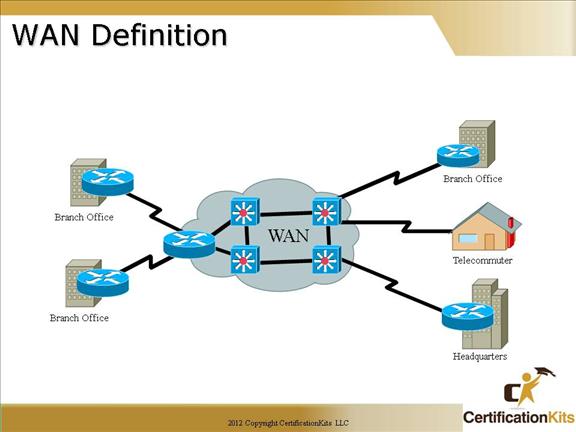
A Wide Area Network (WAN) is similar to a Local Area Network (LAN). The main difference is that a WAN operates beyond the geographic scope of a LAN. The major characteristics of a WAN are as follows:
- • WANs connect devices located in different geographic regions.
- • WANs utilize carriers (WAN service providers) such as cable companies to communicate across the different geographic regions.
- • WANs utilize various types of serial connections (typically lower bandwidth than LANs) for communication.
Cisco CCNA Need for WANs
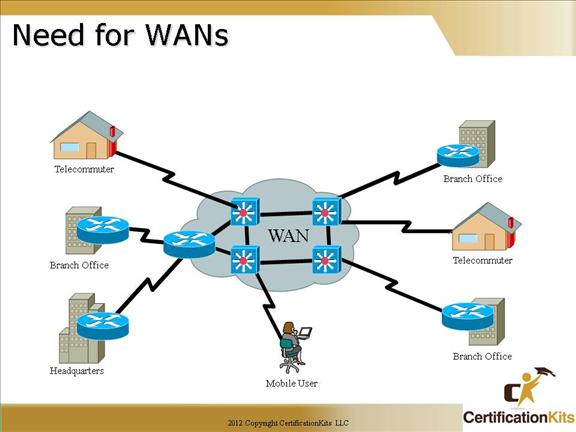
WANs are essential to supporting business needs. Some of the uses for businesses are as follows:
- • Ability to share data between headquarters and branch offices.
- • Ability for employees on company travel to access data residing at the main office.
Home users also need WANs:
- • Imagine not having access to the Internet.
- • Today people perform banking, procurements and many other things utilizing the Internet.
- • Students perform research utilizing the Internet.
Cisco CCNA WANs and the OSI Reference Model
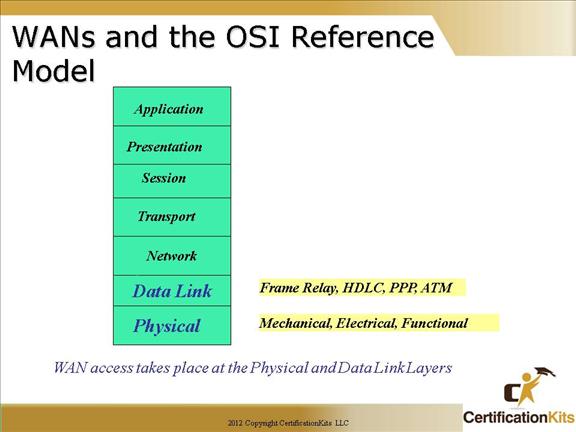
WAN access encompasses both the Physical (Layer 1) and Data Link (Layer 2) layers of the OSI reference model.
The physical layer describes things like mechanical, electrical, functional and operation connections to the service provider.
The data link layer defines how the data is encapsulated. Different WAN technologies utilizes at this layer are frame relay, HDLC, PPP and ATM.
Cisco CCNA WAN Terms
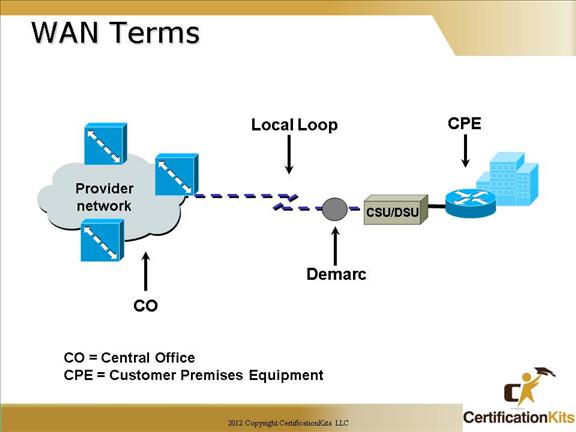
WAN: a data communication network covering a broad geographic area, typically using rented transmission facilities.
Demarc: The boundary between the customer’s in-house wiring and the service providers wiring. It’s the demarcation point, or the end of responsibility for the service provider.
CPE: Customer Premise Equipment refers to all wiring and equipment on the customer’s side of the Demarc.
Local loop: The wiring running from the Demarc to the CO.
CO: (Central Office) The point where the local loop gains access to the service providers high speed trunk lines. This is often referred to as a POP, or Point of Presence.
Cisco CCNA Typical WAN Encapsulation Protocols
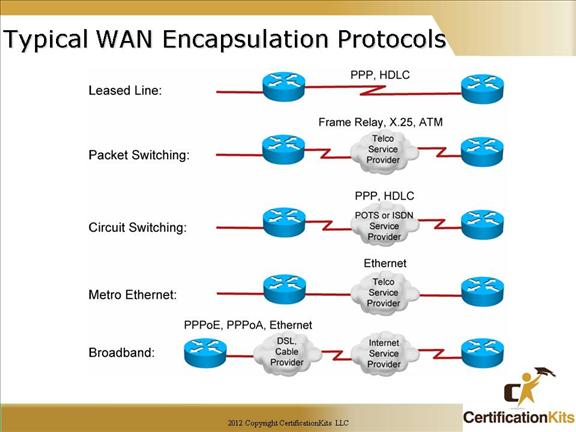
In order to exchange traffic over a WAN link, the packets must be encapsulated into a Layer 2 frame. There are a variety of Layer 2 encapsulation types available that can be used, depending on the WAN connection being used. Some of the types are listed the figure.
Encapsulation must be configured on the router when configuring the interface. Some of these encapsulation types will be seen again in the following chapters.
In an ISDN environment, the Point-to-Point Protocol (PPP) is the B channel’s Layer 2 encapsulation. Link Access Procedure on the D channel (LAPD) is the encapsulation for the D channel.
Either the proprietary Cisco or Internet Engineering Task Force (IETF) (defined in RFC 1490) encapsulations are the Layer 2 encapsulations for Frame Relay.
Cisco CCNA What is a VPN?
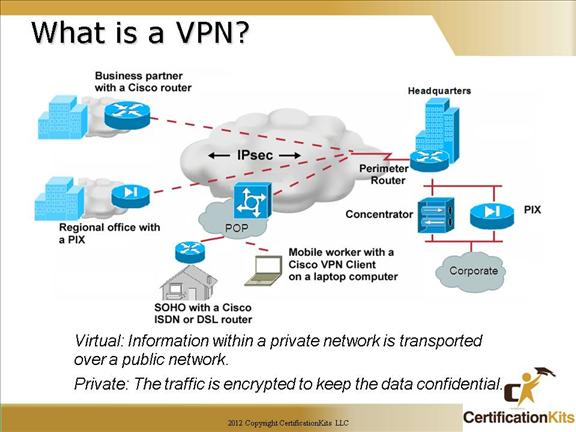
IPsec acts at the network layer, protecting and authenticating IP packets between participating IPsec devices (peers), such as other PIX Firewalls, Cisco routers, VPN 3000 Concentrator Series, Cisco Secure VPN Client, and other IPsec-compliant products. IPsec is a framework of open standards that provides data confidentiality, data integrity, and data authentication between participating peers at the IP layer. IPsec encompasses a suite of protocols. It is not bound to any specific encryption or authentication algorithms, key generation technique, or security association. IPsec supplies the rules while existing algorithms provide the encryption, authentication, key management, and so on. In this way, IPsec can allow the use of updated algorithms and key techniques without patching the IPsec protocol. In this topic, we’ll discuss how those open standards provide data confidentiality, integrity, and authentication.
Cisco CCNA Benifits of VPN
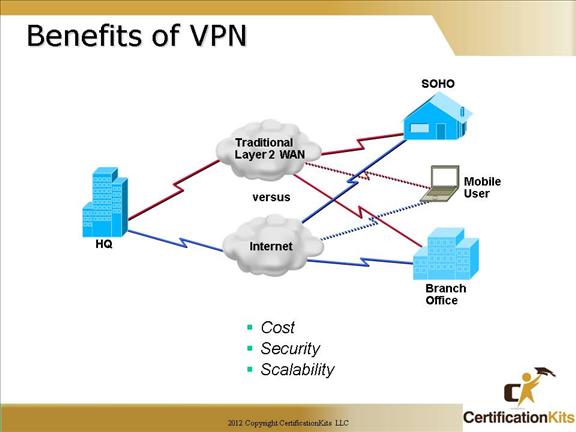
The first VPN solution is remote access. Remote access is targeted to mobile user and Home telecommuters. Most people have access to the Internet from there homes, why not take advantage of it. In the past, corporations supported remote users via dial-in networks. This typically necessitated a toll, or 1-800, call to access the corporation. With the advent of VPNs, a mobile user can make a local call to their ISP to access corporation via Internet wherever they may be. It is an evolution of dial networks. Remote access VPN can support the needs of telecommuters, mobile users, extranet consumer-to-business, and so on.
Cisco CCNA Synchronous vs Asynchronous
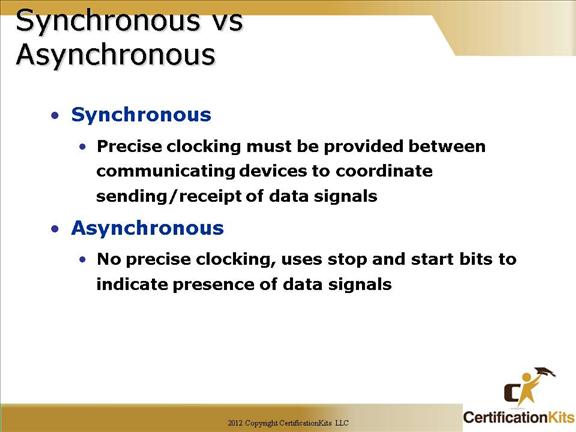
Synchronous transmission advantages:
1. Lower overhead and thus, greater throughput
Synchronous transmission disadvantages:
1. Slightly more complex
2. Hardware is more expensive…
Asynchronous transmission advantages:
1. Simple, doesn’t require synchronization of both communication sides
2. Cheap, timing is not as critical as for synchronous transmission, therefore hardware can be made cheaper
3. Set-up is very fast, so well suited for applications where messages are generated at irregular intervals, for example data entry from the keyboard
Asynchronous transmission disadvantages:
1. Large relative overhead, a high proportion of the transmitted bits are uniquely for control purposes and thus carry no useful information
Cisco CCNA HDLC
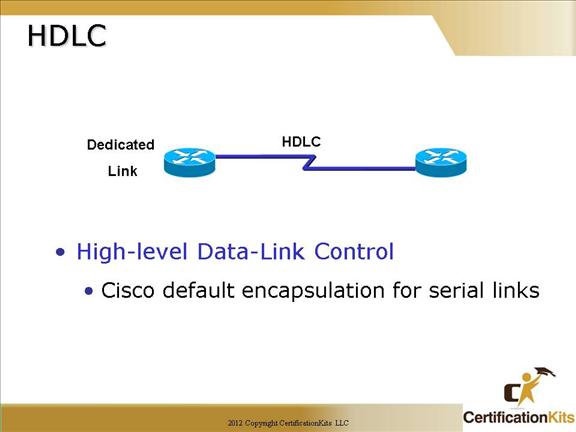
The High-Level Data-Link Control protocol (HDLC) is a popular ISO-standard, bit-oriented Data Link layer protocol. It specifies an encapsulation method for data on synchronous serial data links using frame characters and checksums. HDLC is a point-to-point protocol used on leased lines. No authentication can be used with HDLC.
HDLC is the default encapsulation used by Cisco routers over synchronous serial links. Let’s repeat that, HDLC is the default encapsulation used by Cisco on synchronous serial links. Cisco’s HDLC is proprietary—it won’t communicate with any other vendor’s HDLC implementation—but don’t give Cisco grief for it; everyone’s HDLC implementation is proprietary.
Cisco CCNA HDLC Frame Format
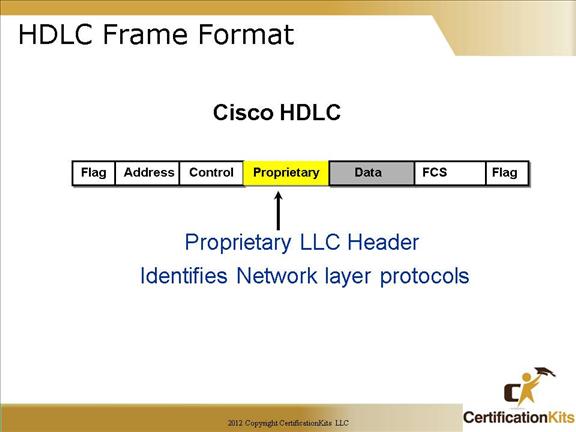
HDLC is the default layer 2 protocol for Cisco router serial interfaces. Cisco’s proprietary enhancement to HDLC incorporates a protocol or type field to allow multiple protocols to be carried on a single link.
